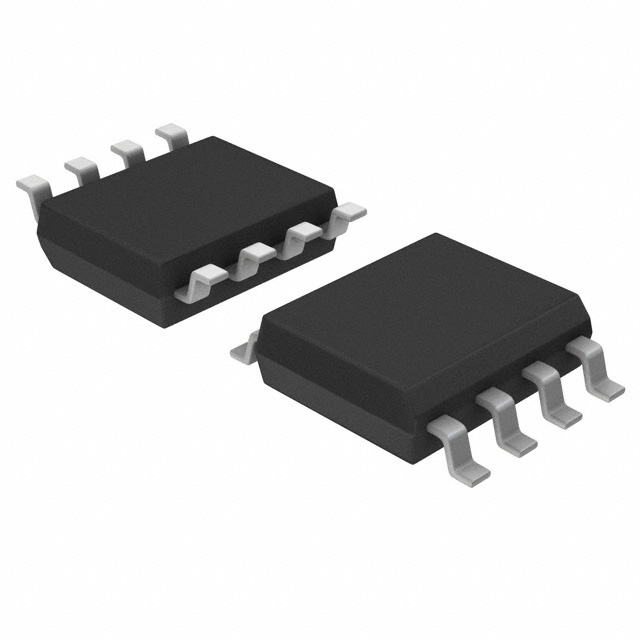Xem thông số kỹ thuật để biết chi tiết sản phẩm.

LMH6551MA/NOPB
Product Overview
Category: Integrated Circuit (IC)
Use: The LMH6551MA/NOPB is a high-speed operational amplifier designed for use in various applications that require wide bandwidth and high slew rate. It is commonly used in audio and video equipment, communication systems, and instrumentation.
Characteristics: - Wide Bandwidth: The LMH6551MA/NOPB offers a bandwidth of up to 1 GHz, making it suitable for high-frequency applications. - High Slew Rate: With a slew rate of 4100 V/µs, this operational amplifier can handle fast voltage changes efficiently. - Low Distortion: It provides low total harmonic distortion (THD) and excellent linearity, ensuring accurate signal amplification. - Low Input Bias Current: The LMH6551MA/NOPB has a low input bias current, minimizing the impact of input impedance on the circuit performance.
Package: The LMH6551MA/NOPB comes in a small outline integrated circuit (SOIC) package, which provides ease of handling and compatibility with standard PCB designs.
Essence: This operational amplifier is designed to amplify signals accurately and efficiently in high-speed applications, ensuring minimal distortion and high fidelity.
Packaging/Quantity: The LMH6551MA/NOPB is typically packaged in reels containing 250 units, providing convenience for mass production and assembly processes.
Specifications
- Supply Voltage Range: ±5V to ±15V
- Input Voltage Range: ±3V
- Output Voltage Swing: ±2.8V
- Gain Bandwidth Product: 1 GHz
- Slew Rate: 4100 V/µs
- Input Bias Current: 10 nA
- Total Harmonic Distortion: 0.01%
- Operating Temperature Range: -40°C to 85°C
Pin Configuration
The LMH6551MA/NOPB has a standard 8-pin SOIC package with the following pin configuration:
```
| | --| V- OUT |-- --| V+ IN- |-- --| NC IN+ |-- --| NC VCC |-- --| NC GND |-- --| NC NC |-- --| NC NC |-- |___________| ```
Functional Features
- High-Speed Amplification: The LMH6551MA/NOPB offers a wide bandwidth and high slew rate, allowing it to amplify high-frequency signals accurately.
- Low Distortion: With low total harmonic distortion, this operational amplifier ensures minimal signal degradation during amplification.
- Stable Operation: It provides excellent stability and linearity, making it suitable for applications that require precise signal processing.
- Low Power Consumption: The LMH6551MA/NOPB operates at low power, reducing energy consumption and heat generation.
Advantages and Disadvantages
Advantages: - Wide bandwidth and high slew rate enable accurate amplification of high-frequency signals. - Low distortion ensures faithful reproduction of the input signal. - Excellent stability and linearity contribute to precise signal processing. - Low power consumption reduces energy consumption and heat generation.
Disadvantages: - Limited voltage swing may restrict its use in applications requiring larger output voltage ranges. - Not suitable for low-power applications where ultra-low power consumption is required.
Working Principles
The LMH6551MA/NOPB is based on a high-speed operational amplifier architecture. It utilizes advanced circuitry and design techniques to achieve wide bandwidth, high slew rate, and low distortion. The internal circuitry includes differential input stages, gain stages, and output buffers, all optimized for high-speed operation.
When an input signal is applied to the LMH6551MA/NOPB, it undergoes amplification through the various stages of the operational amplifier. The amplified signal is then available at the output pin for further processing or transmission.
Detailed Application Field Plans
The LMH6551MA/NOPB finds applications in various fields, including:
Audio and Video Equipment:
- High-fidelity audio amplifiers
- Video signal amplification and processing circuits
Communication Systems:
- Wideband RF amplifiers
- Signal conditioning circuits for data transmission
Instrumentation:
- Oscilloscope front-end amplifiers
- Test and measurement equipment
Medical Devices:
- Ultrasound signal amplification
- Biomedical instrumentation
Detailed and Complete Alternative Models
- AD8001ARZ: High-Speed Amplifier with 1 GHz Bandwidth and Low Distortion.
- MAX410ESA+: Precision Operational Amplifier with Wide Bandwidth and Low Noise.
- OPA656N/250: High-Speed Operational Amplifier with 550 MHz Bandwidth and Low Power Consumption.
- LT
Liệt kê 10 câu hỏi và câu trả lời thường gặp liên quan đến ứng dụng LMH6551MA/NOPB trong giải pháp kỹ thuật
Question: What is the typical supply voltage range for LMH6551MA/NOPB?
Answer: The typical supply voltage range for LMH6551MA/NOPB is 2.7V to 12V.Question: What is the bandwidth of LMH6551MA/NOPB?
Answer: The bandwidth of LMH6551MA/NOPB is 900MHz.Question: Can LMH6551MA/NOPB be used in single-supply applications?
Answer: Yes, LMH6551MA/NOPB can be used in single-supply applications.Question: What is the input voltage noise density of LMH6551MA/NOPB?
Answer: The input voltage noise density of LMH6551MA/NOPB is 2.9nV/√Hz.Question: Is LMH6551MA/NOPB suitable for high-speed signal amplification?
Answer: Yes, LMH6551MA/NOPB is suitable for high-speed signal amplification.Question: What is the typical input offset voltage of LMH6551MA/NOPB?
Answer: The typical input offset voltage of LMH6551MA/NOPB is 0.1mV.Question: Can LMH6551MA/NOPB be used in video distribution systems?
Answer: Yes, LMH6551MA/NOPB can be used in video distribution systems.Question: What is the power consumption of LMH6551MA/NOPB?
Answer: The power consumption of LMH6551MA/NOPB is typically 3.5mA per channel.Question: Does LMH6551MA/NOPB have built-in thermal shutdown protection?
Answer: No, LMH6551MA/NOPB does not have built-in thermal shutdown protection.Question: Can LMH6551MA/NOPB be used in RF communication systems?
Answer: Yes, LMH6551MA/NOPB can be used in RF communication systems.

